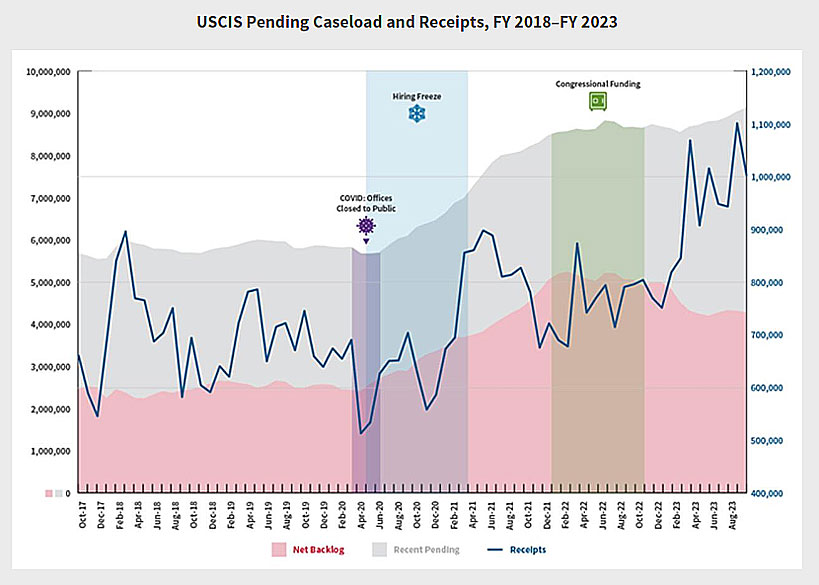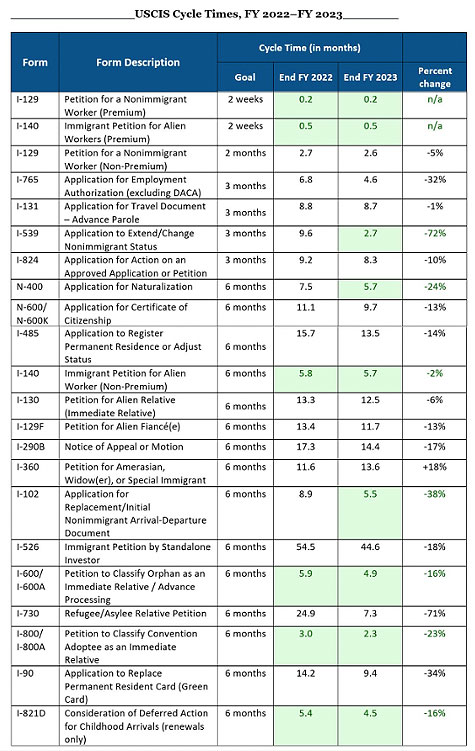This sponsored column is by Law Office of James Montana PLLC. All questions about it should be directed to James Montana, Esq., Doran Shemin, Esq., Janice Chen, Esq., and Austen Soare, Esq., practicing attorneys at The Law Office of James Montana PLLC, an immigration-focused law firm located in Falls Church, Virginia. The legal information given here is general in nature. If you want legal advice, contact us for an appointment.
USCIS recently put out a press release written by the same comms professionals who brought you The Deeds of the Divine Augustus and Dirt Off Your Shoulder.
In a word, they’re very proud of themselves. “Completing an Unprecedented 10 Million Immigration Cases in Fiscal Year 2023, USCIS Reduced Its Backlog for the First Time in Over a Decade” is a strutting, fist-pumping shout of victory.
But is it justified by the facts? We report, you decide!
First, here’s USCIS’s version of events.
- In FY2023, USCIS received almost eleven million applications and adjudicated more than ten million cases, thereby reducing the backlog for the first time in over a decade.
- USCIS naturalized 875,000 new US citizens, including 12,000 members of the U.S. military; in the course of eliminating the naturalization backlog, USCIS decreased the processing time for a naturalization application from 10.5 months to about six months.
- USCIS broke new ground in humanitarian relief cases. USCIS’s asylum directorate completed 52,000 asylum cases, created a sixth Service Center to process humanitarian relief cases more efficiently, and expanded both the U4U (Uniting for Ukraine) and CHNV (Cuba-Honduras-Nicaragua-Venezuela) parole processes in support of the Biden Administration’s efforts to regularize migration at the border.
- USCIS improved its systems for making appointments at local field offices, including encouraging applicants to change their appointments online
Now, here’s our take.
Look at this chart from USCIS’s press release:
USCIS wants you to see that the net backlog has declined from roughly 800,000 to roughly 750,000 between October 2022 and October 2023 — that’s the red-shaded area.
But the chart itself — and let’s give credit to USCIS for credible data disclosure here — offers a countervailing narrative. The ‘recent receipts’ area (grey-shaded) and the somewhat spikier ‘receipts’ line show that USCIS is receiving an enormous amount of new applications. That’s a very bad sign for the backlog. Unless USCIS can handle roughly 30% more applications this year than it handled last year, without the supplemental Congressional funding that sluiced through the system in FY2022, the backlog is going to skyrocket again. We predict that will happen.
Now, look at the chart that USCIS provides for its application cycle times:
What’s missing from this chart? Only the two most important forms in the entire immigration system. The green card application (Form I-485) and the asylum application (Form I-589) simply aren’t there. The reason why is anyone’s guess. We can tell you from experience, though, that affirmative asylum cases aren’t getting interviews for years and that green card processing times are down, not up.
As a matter of fairness, we’re happy to report that the progress on naturalization applications is real. Many of our clients are getting their naturalization interviews within months of filing the applications, and this is a wonderful thing. We love making new U.S. citizens, and the drive to get these cases done is palpable at our local field offices in Fairfax and Baltimore.
On the whole, though, the picture is not as rosy as USCIS suggests. This small decline in the backlog is welcome, but unlikely to persist; and applicants continue to face long waits for green card interviews (and, especially) affirmative asylum cases.
As always, we welcome your comments and will do our best to respond.





